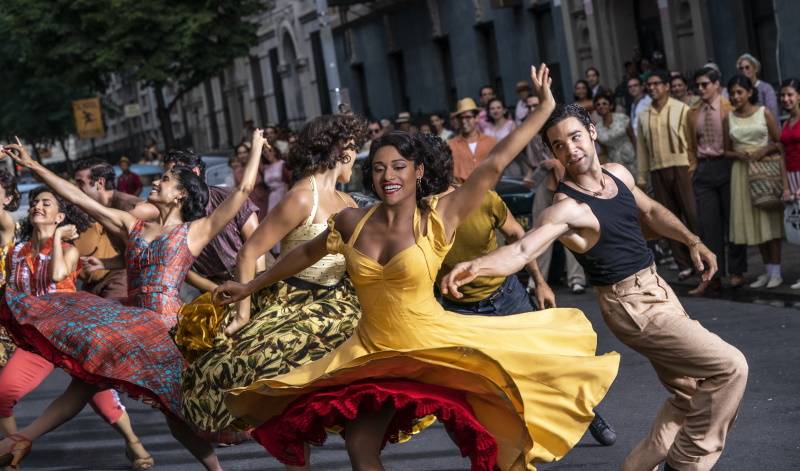‘West Side Story’ Deserves Bigger Audience
It’s a great film, with seven Oscar nods but should have gotten eight.

Ariana DeBose as Anita and David Alvarez as Bernardo in 20th Century Studios’ WEST SIDE STORY. Photo by Niko Tavernise. © 2020 Twentieth Century Fox Film Corporation. All Rights Reserved.
Six decades of children turning into teenagers turning into parents turning into grandparents. From family movie night at the local palatial palace for the Natalie Wood version of “West Side Story” (1961) then after a decade a TV perennial, then forgotten by movie palaces turning into multiplexes, then the pandemic comes along confusing movies with home streaming services, then teens preferring the video joys on their smart phones to ever going out to a movie with mom and dad — what changes in the entertainment habit! These shifts now greet the most successful moviemaker in history, director Steven Spielberg, for his re-thought remake of West Side Story.
Spielberg makes more money signing a deal than I could imagine in a lifetime, so he can afford to out wait an uncertain public as his $100 million outing has brought in to date only $37 million at the box office. Those figures will jump around March 2 when the movie-house-only decision gives way to Disney Plus and HBO Max.
One reason is respect for the original. You’ll find visual echoes of director Robert Wise such as the colors coming through windows panes. Choreographer Justin Peck pays constant homage to the other original director Jerome Robbins (yes, there were two) for the dance numbers – less finger snapping and fewer scoops to the ground but the same syncopated action, more synchronized ballet twirls, more lunging forward in groups, the same Robbins power and virile strength, even extended street dances with more people involved, including kids.
Where Wise started with high aerial views, Spielberg brings the story closer to the ground as wrecking balls skim the dilapidated turf where the Lincoln Center is going up in the 1950s. Oscar nominated cinematographer Janusz Kaminski, a Spielberg veteran, provides exceptional images without calling attention to how shrewdly his cameras have been placed, particularly noteworthy in the intimate singing scenes.
Spielberg has daringly changed “Cool” into a keep-away fight for a gun with extraordinary leaps. He has moved “I Feel Pretty” to provide irony after the rumble – it is performed by an unknowingly happy Maria and minimum wage Puerto Ricans (no subtitles needed) cleaning up Gimbel’s. The rumble draws Tony in with more brutality and psychological whiplash.
Screenwriter Tony Kushner has moments of brilliance. He has not thrown away Arthur Laurents’ Broadway book with its invented slang but he has augmented with powerful back-stories, clever changes in sequence, and extended dialogue face-offs that explain more deeply the friendship of Tony and Riff and clearly make Maria the aggressive one in her romance with Tony. Even Chino, Maria’s hulky boy friend who intends to shoot Tony, is fleshed out into a believable character by Josh Andrés Rivera.
It will take several viewings for the other members of the Jets and the Sharks to take on the individuality the public bestowed on the originals, but Spielberg is making sure that each will have that sort of moment. The fight over turf and racism is more cutting in language with neighborhood adults added for humor and street shock (we no longer feel the youth gangs are aliens dropped from space).
Virtually all the Jets and Sharks have Broadway experience, and the combination of choreography and singing demands those skills. Leonard Bernstein’s music has never sounded better and Spielberg marries the music to the settings as intended in special ways I had not thought about when seeing the 1961 version.
The Anita of Ariana DeBose is Oscar nominated, delightfully smiling and swirling her skirt but also grimly dark and mature in the tragic scenes. She is being allowed to suffer and strike back in manners different than Rita Moreno as the first Anita, and that brings up an interesting Oscar exclusion.
Rachel Zegler was plucked not from Broadway but from 30,000 audition tapes to be Maria. Of course her face and eyes are luminous. More important her soprano is lovely especially in the higher range and her acting grows in firmness, capturing the innocence as well as the determination in important dialogue additions.
The surprise to me about the remake is that the power of the music is improved. It is not just better sound technology (also nominated for an Oscar), but the major difference in people actually singing the parts they are playing. There are no big celebrity names that require dubbing as was standard in 1961.
I know all about pre-recording and the like, and the studio has gone out of its way to describe how much was captured live. But either way it is amazingly more human and freeing for this A-list of Spielberg collaborators when Tony and Maria are actually singing and looking at each other, as opposed to imported voices like Jimmy Bryant and Marni Nixon in the original.
Nor is the movie a new plaything for people seeking those “Easter eggs,” the Spielberg touches in how the story is told, like the color red in “Schindler’s List” or the John Ford scene in “E.T.” The actual touches are in the craftsmen he hired and the way he keeps the camera moving among the players – and the way the story adds believability.
This is a fine film and audiences will discover it at their own pace. Of all the film makers today, Spielberg is the one of such high regard that he can wait patiently for that fickle audience to find him.
Dominique Paul Noth served for decades as film and drama critic, later senior editor for features at the Milwaukee Journal. You’ll find his blog here and here.
Movies
-
Milwaukee Film Festival Returns in April
 Mar 27th, 2024 by Sophie Bolich
Mar 27th, 2024 by Sophie Bolich
-
Nina Simone’s Summer of Soul
 Nov 29th, 2022 by John Sieger
Nov 29th, 2022 by John Sieger
-
The Surprise Pick for Best Picture
 Mar 22nd, 2022 by Dominique Paul Noth
Mar 22nd, 2022 by Dominique Paul Noth
Review
-
Ouzo Café Is Classic Greek Fare
 May 23rd, 2024 by Cari Taylor-Carlson
May 23rd, 2024 by Cari Taylor-Carlson
-
‘The Treasurer’ a Darkly Funny Family Play
 Apr 29th, 2024 by Dominique Paul Noth
Apr 29th, 2024 by Dominique Paul Noth
-
Anmol Is All About the Spices
 Apr 28th, 2024 by Cari Taylor-Carlson
Apr 28th, 2024 by Cari Taylor-Carlson




















